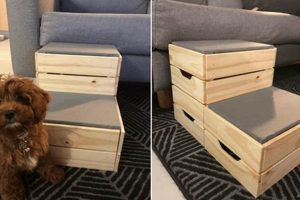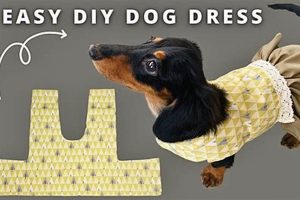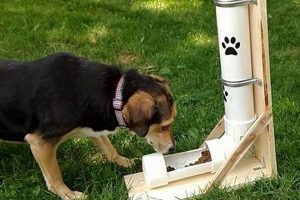The concept involves creating stimulating activities and toys for canines using readily available household items. These homemade provisions aim to enhance a dog’s mental and physical well-being. An example includes constructing a puzzle feeder from a muffin tin and tennis balls, requiring the dog to problem-solve to access treats.
Such activities are valuable because they combat boredom, reduce destructive behaviors, and satisfy a dog’s natural instincts to forage, chew, and explore. Historically, dog owners relied on simple walks and fetch games. Today, there’s growing recognition that mental stimulation is equally vital for a balanced and happy canine companion. A focus on more stimulating activities is a growing trend.
The following sections will detail numerous ideas for developing these enrichment projects at home, providing guidelines on safety and customization to suit individual dog needs and preferences, and addressing how to introduce novel enrichment items effectively.
Practical Advice for Home-Based Canine Enrichment
The subsequent recommendations are intended to guide the safe and effective implementation of environmental modifications and activity provisions designed to enhance a dog’s well-being.
Tip 1: Prioritize Safety. All materials used in constructing enrichment items must be non-toxic and free from small parts that could be ingested, causing choking or digestive obstruction. Regularly inspect items for wear and tear, replacing them as needed.
Tip 2: Observe Canine Behavior. Monitor the dog’s interaction with new enrichment items. Positive indicators include engagement, problem-solving, and a relaxed demeanor. If the dog exhibits frustration, aggression, or disinterest, modify the activity or introduce it more gradually.
Tip 3: Rotate Enrichment Options. Dogs habituate to stimuli over time. To maintain engagement, rotate available enrichment items on a regular basis. This keeps the environment fresh and prevents boredom.
Tip 4: Consider Individual Needs. Tailor enrichment activities to the dog’s age, breed, energy level, and physical abilities. A senior dog with arthritis will require gentler activities than a young, energetic herding breed.
Tip 5: Introduce Novelty Gradually. Avoid overwhelming the dog with too many new items at once. Introduce enrichment one at a time, allowing the dog to acclimate to each new experience.
Tip 6: Supervise Initial Interactions. For new enrichment items, supervise the dog’s initial interactions to ensure safe and appropriate use. This is particularly important for items that involve food or require problem-solving.
Tip 7: Cleanliness is Crucial. Regularly clean enrichment items, especially those involving food, to prevent bacterial growth and maintain hygiene. Dishwasher-safe items are preferred for ease of cleaning.
By adhering to these guidelines, individuals can effectively improve their canine companions’ quality of life, fostering mental stimulation, reducing behavioral issues, and strengthening the human-animal bond.
The remaining sections of this document will address additional considerations for implementing a comprehensive environmental enrichment plan, including appropriate dietary considerations and further behavioral modifications.
1. Safety Assessment
In the realm of at-home enrichment creation for canines, a thorough safety assessment is paramount. This process ensures that the activities and items introduced do not pose risks of injury, illness, or undue stress to the animal. The absence of a rigorous evaluation can lead to adverse outcomes, undermining the intended benefits of these enrichment efforts.
- Material Integrity
The physical properties of materials used are a central concern. Enrichment items must be constructed from durable materials resistant to splintering, shattering, or disintegration under normal use. Small, detachable components present a significant choking hazard and should be avoided. Examples include replacing brittle plastic with reinforced rubber or substituting sewn seams for glued joints to prevent separation. Inadequate material selection can result in gastrointestinal blockages or lacerations.
- Toxicity Evaluation
The chemical composition of enrichment materials requires careful scrutiny. Paints, adhesives, and textiles must be certified non-toxic and free from heavy metals or volatile organic compounds. Dogs often mouth or chew on enrichment items, increasing the potential for ingestion of harmful substances. Opting for food-grade plastics, natural fibers, and water-based paints mitigates this risk. Neglecting this aspect could lead to poisoning or allergic reactions.
- Size and Shape Considerations
The dimensions and configuration of enrichment items must align with the dog’s size, breed, and physical capabilities. Items that are too small can be easily swallowed, while those that are too large may be unwieldy or inaccessible. Sharp edges, protruding elements, and entrapment hazards must be eliminated. An appropriately sized puzzle feeder, for example, should allow the dog to manipulate it effectively without causing injury. Ignoring these considerations could lead to physical trauma or frustration.
- Supervision and Monitoring Protocols
Even with careful material selection and design, consistent supervision of the dog’s interaction with new enrichment items is necessary. Observation allows for prompt intervention in the event of unintended use, such as destructive chewing or ingestion of small parts. Regular inspection of enrichment items for wear and tear is equally crucial. Implementing a schedule for replacing or repairing damaged items minimizes the risk of injury. A failure to supervise and monitor can negate the benefits of safety measures implemented during the design phase.
These facets illustrate that a safety assessment is not a singular event but an ongoing process integrated into every stage of at-home enrichment creation. Examples include puzzle toys for senior dogs with limited mobility. They are safe for their age group. The absence of such rigor may diminish the quality of life.
2. Material Selection
Material selection constitutes a foundational element in the safe and effective creation of at-home canine enrichment items. The properties of chosen materials directly influence the durability, safety, and overall suitability of these provisions, impacting the animal’s physical and psychological well-being.
- Non-Toxicity
The paramount consideration in material selection is the assurance of non-toxicity. Canines frequently mouth or chew on enrichment items; therefore, all materials must be free from harmful chemicals, heavy metals, and volatile organic compounds. Examples of safe choices include food-grade plastics, untreated wood, and natural fibers. Conversely, materials such as lead-based paints, chemically treated textiles, and certain types of rubber pose significant health risks. Failure to prioritize non-toxicity can result in poisoning, allergic reactions, or long-term health complications.
- Durability and Resistance
The chosen materials must exhibit sufficient durability and resistance to withstand the intended use. Enrichment items are subjected to varying degrees of stress, including chewing, scratching, and repetitive manipulation. Weak or brittle materials are prone to breakage, creating potential hazards such as sharp edges or small, ingestible fragments. Durable materials such as reinforced nylon, thick canvas, and hardwood are better suited for withstanding rigorous use. The application of insufficient strength can lead to premature product failure and increased risk of injury.
- Cleanability and Hygiene
Maintaining hygiene is critical in preventing the spread of bacteria and ensuring the animal’s health. Materials selected for enrichment items should be easily cleaned and sanitized. Non-porous surfaces such as stainless steel or certain plastics are preferable to porous materials such as untreated wood or absorbent fabrics. Dishwasher-safe materials offer added convenience and ensure thorough cleaning. Neglecting cleanability considerations can result in bacterial growth, unpleasant odors, and potential health risks.
- Environmental Impact
The environmental impact of material selection is an increasingly important consideration. Choosing sustainable and eco-friendly materials reduces the overall environmental footprint of canine enrichment practices. Recycled plastics, bamboo, and sustainably harvested wood represent environmentally conscious alternatives to conventional materials. Minimizing waste through the use of durable, long-lasting materials further contributes to sustainability efforts. Disregarding the environmental impact can perpetuate unsustainable consumption patterns and contribute to environmental degradation.
These considerations illustrate the multi-faceted nature of material selection in the context of at-home enrichment creation for canines. A thoughtful approach that prioritizes safety, durability, hygiene, and environmental impact maximizes the benefits of enrichment while minimizing potential risks. For instance, toys designed to be filled with dog food. This requires frequent cleanings due to the accumulation of saliva and food debris. Careful choices can boost animal welfare.
3. Cognitive Challenge
Cognitive challenge, in the context of at-home enrichment creation for canines, refers to the implementation of activities that stimulate mental processes such as problem-solving, decision-making, and memory. These challenges are crucial for maintaining neurological health, preventing boredom-related behavioral issues, and enhancing overall well-being in domestic dogs. Well-designed enrichment leverages a dog’s natural cognitive abilities.
- Puzzle Complexity
The degree of complexity in puzzle-based enrichment directly affects the cognitive load placed on the animal. Starting with simple puzzles and gradually increasing difficulty as the dog masters each stage provides an appropriate level of challenge. For example, a novice might begin with a puzzle requiring them to knock over a container to release treats. Subsequently, the difficulty could increase, progressing to puzzles involving multiple steps or manipulations to achieve the same goal. Overly simplistic puzzles provide little mental stimulation, while excessively difficult puzzles can lead to frustration and disengagement.
- Novelty and Variety
Introducing new and varied cognitive challenges is essential to prevent habituation and maintain engagement. Regularly rotating enrichment items and introducing novel tasks ensures that the dog continues to encounter new problem-solving scenarios. This may involve alternating between different types of puzzles, incorporating scent-based activities such as hiding treats, or introducing new training exercises. A lack of novelty can lead to reduced interest and a decline in cognitive stimulation.
- Sensory Stimulation
Enrichment activities that engage multiple senses can provide a more comprehensive cognitive challenge. Incorporating elements that stimulate sight, smell, hearing, and touch can enhance the dog’s perception of its environment and encourage exploration. For example, a foraging box filled with various textures and scents can stimulate the dog’s olfactory and tactile senses while requiring it to search for hidden treats. Sensory deprivation can limit cognitive development and lead to sensory-seeking behaviors.
- Problem-Solving Opportunities
Providing opportunities for dogs to solve problems independently is a key component of cognitive enrichment. Activities that require the dog to analyze a situation, develop a strategy, and execute a plan promote critical thinking and decision-making skills. This may involve tasks such as opening a latch to access a toy, navigating an obstacle course, or figuring out how to extract food from a complex feeder. Lack of problem-solving opportunities can result in learned helplessness and decreased cognitive flexibility.
The principles of cognitive challenge are integral to maximizing the effectiveness of enrichment strategies. A nuanced understanding of puzzle designs, variety of approaches, sensory elements and problem solving is key. Creating novel cognitive stimulations keeps dogs mentally active.
4. Instinctual Engagement
Instinctual engagement, when considered within the framework of at-home canine enrichment, involves the design and implementation of activities that appeal directly to a dog’s innate behaviors and drives. Recognizing and channeling these inherent tendencies through enrichment endeavors is paramount for promoting psychological well-being and mitigating maladaptive behaviors.
- Foraging Behavior
Foraging represents a fundamental instinct in canines, driving them to actively seek out and acquire food resources. At-home enrichment can harness this instinct through the creation of puzzle feeders or scattered feeding scenarios. Rather than simply providing food in a bowl, these methods require the dog to expend energy and employ problem-solving skills to access their meals. Example: hiding kibble in a snuffle mat, stimulating the dog’s sense of smell and encouraging active searching. Appealing to this natural drive reduces boredom and provides mental stimulation.
- Predatory Sequence
The predatory sequence, encompassing the stages of searching, stalking, chasing, catching, and dissecting, is deeply ingrained in the canine behavioral repertoire. While domesticated dogs may not require these skills for survival, the underlying instincts remain. Enrichment activities can mimic aspects of this sequence in a safe and controlled manner. Example: using a flirt pole to simulate the chase and capture of prey, or providing appropriate chew toys that allow the dog to engage in simulated dissection. Satisfying these predatory instincts can reduce the likelihood of destructive behaviors directed towards inappropriate targets.
- Social Interaction
Dogs are inherently social animals, deriving comfort and security from interactions with conspecifics and humans. Enrichment should incorporate opportunities for social engagement, even in single-dog households. Example: providing opportunities for interactive play with the owner, or arranging supervised playdates with other dogs. In the absence of direct social contact, enrichment can involve visual or auditory stimulation related to social interaction, such as playing recordings of canine vocalizations. Addressing social needs is crucial for preventing isolation and promoting emotional stability.
- Chewing and Oral Exploration
Chewing serves multiple purposes for canines, including maintaining dental hygiene, relieving stress, and exploring their environment. Providing appropriate chew toys and allowing opportunities for controlled chewing is essential for satisfying this instinct. Example: offering a variety of chew toys with different textures and densities, or providing a frozen Kong filled with palatable ingredients. Restricting chewing can lead to frustration, dental problems, and destructive chewing of inappropriate items. Allowing for appropriate oral exploration addresses a fundamental need and contributes to overall well-being.
The successful implementation of at-home canine enrichment relies heavily on understanding and catering to these core instincts. By designing activities that appeal directly to a dog’s innate drives, owners can foster psychological well-being, reduce behavioral problems, and strengthen the human-animal bond. Considering natural behaviors can transform everyday items to powerful resources.
5. Environmental Rotation
Environmental rotation, in the context of creating at-home enrichment for canines, is the systematic and periodic alteration of available stimuli within the animal’s environment. This deliberate manipulation is undertaken to prevent habituation, maintain engagement, and maximize the cognitive and behavioral benefits derived from enrichment efforts. It serves as a core component of a proactive enrichment strategy.
- Stimulus Novelty Maintenance
The primary objective of environmental rotation is to introduce new stimuli or reintroduce familiar stimuli in novel contexts. This strategy prevents the animal from becoming desensitized to specific enrichment items or activities, ensuring sustained interest and cognitive engagement. For example, a puzzle feeder that has been consistently available for an extended period may lose its appeal. By temporarily removing the puzzle and reintroducing it later, perhaps in a different location or with a different type of food, the dog’s renewed interest can be triggered. Neglecting stimulus novelty results in diminished engagement and a corresponding reduction in the benefits of enrichment.
- Predictability Reduction
Environmental rotation inherently reduces the predictability of the animal’s surroundings, fostering a more stimulating and challenging environment. When enrichment items and activities are consistently available in the same location and at the same time, the animal can anticipate their presence and develop predictable routines. By varying the timing, location, and availability of enrichment, the animal is compelled to remain vigilant and adaptive. Example: altering the placement of chew toys or changing the schedule for interactive play sessions. Predictability can lead to boredom and reduced cognitive flexibility.
- Cognitive Re-engagement
The introduction of new or reconfigured enrichment items necessitates cognitive re-engagement. When a familiar item is presented in a new context, the animal must re-evaluate its properties and develop new strategies for interacting with it. This process stimulates cognitive processes such as problem-solving, decision-making, and spatial awareness. For example, introducing a new scent trail or modifying the configuration of an agility course requires the animal to adapt and learn. Cognitive stagnation can result from a static environment.
- Behavioral Modification Potential
Environmental rotation can be strategically employed to modify undesirable behaviors. By manipulating the availability of specific enrichment items, the animal’s focus can be redirected away from problematic behaviors towards more constructive activities. For instance, if a dog exhibits destructive chewing behavior, providing a novel chew toy during periods of increased anxiety may divert its attention away from damaging household items. Additionally, the periodic removal of certain stimuli can help to extinguish undesirable associations. Behavioral persistence is increased with predictable circumstances.
These facets of environmental rotation are essential for maximizing the effectiveness of at-home enrichment endeavors. By maintaining stimulus novelty, reducing predictability, promoting cognitive re-engagement, and facilitating behavioral modification, environmental rotation ensures that enrichment efforts continue to provide meaningful benefits to the animal. Furthermore, implementing a well-structured rotation plan provides a framework for adapting enrichment strategies to the individual needs and preferences of each dog. A systematic approach, therefore, contributes to overall well-being.
6. Behavioral Observation
Behavioral observation forms an indispensable component of any at-home canine enrichment program. It enables the continuous assessment of a dog’s responses to novel stimuli and activities, ensuring both the animal’s safety and the efficacy of enrichment efforts. Accurate observations provide the data necessary for refinement and personalization of enrichment strategies.
- Engagement Level Assessment
Assessment of a dog’s engagement level facilitates the identification of activities that are both stimulating and appropriately challenging. Active participation, sustained interest, and positive affect (e.g., tail wagging, relaxed body posture) are indicative of successful engagement. Conversely, disinterest, frustration, or avoidance behaviors signal that an activity may be too difficult, unappealing, or even fear-inducing. For example, if a dog consistently ignores a particular puzzle feeder, it suggests the puzzle’s complexity is either too low or too high. Engagement levels inform the selection and modification of enrichment activities to optimize their impact.
- Stress Signal Recognition
Recognizing stress signals is critical for preventing negative experiences and ensuring the animal’s well-being. Signs of stress may include lip licking, yawning, panting, whale eye (showing the whites of the eyes), a tucked tail, or attempts to escape. These signals indicate that an enrichment activity is causing anxiety or discomfort. Example: a dog displaying lip licking and a tucked tail while interacting with a novel object suggests it is feeling apprehensive. Prompt identification of stress signals allows for immediate removal of the offending stimulus or modification of the activity to reduce its aversiveness.
- Behavioral Modification Tracking
Behavioral observation enables the tracking of behavioral changes resulting from enrichment interventions. Enrichment can be strategically employed to reduce undesirable behaviors, such as excessive barking, destructive chewing, or separation anxiety. Consistent monitoring of these behaviors allows for objective assessment of the enrichment program’s effectiveness. Example: recording the frequency of barking episodes before and after the introduction of a foraging activity can determine if the enrichment is successfully redirecting the dog’s energy. Data on behavior modifications inform ongoing adjustments to the enrichment plan.
- Individual Preference Identification
Through observation, individual preferences for specific enrichment items and activities can be discerned. Dogs, like humans, exhibit unique preferences based on their temperament, breed characteristics, and past experiences. Observing which toys a dog consistently selects, which activities elicit the most enthusiasm, and which sensory stimuli it seems to enjoy most allows for the creation of a highly personalized enrichment plan. Example: noting that a dog consistently chooses to play with a ball over other toys suggests a high ball drive, which can be leveraged in future enrichment activities. Tailoring enrichment to individual preferences maximizes its impact and fosters a stronger human-animal bond.
In summation, behavioral observation is not merely a passive process but an active and continuous evaluation integrated into the implementation of at-home canine enrichment. From assessment of engagement to stress signal recognition, to the tracking of behavioral changes, each facet is carefully recorded to ensure an effective and beneficial enrichment program. The insights derived are then used to tailor and refine strategies, ultimately optimizing the animal’s well-being. Examples may vary but goals remain the same.
7. Hygiene Maintenance
Hygiene maintenance constitutes a crucial, often overlooked, aspect of crafting and sustaining at-home enrichment provisions for canines. The materials and designs employed in these activities, intended to enhance a dog’s physical and cognitive well-being, necessitate rigorous attention to cleanliness to prevent the proliferation of harmful bacteria and pathogens.
- Material Sanitation Protocols
The materials used in making toys and puzzles are susceptible to contamination. Fabrics may harbor dust mites or mold, while plastic and rubber items can accumulate saliva and food residue, fostering bacterial growth. Rigorous cleaning protocols, including washing fabrics at high temperatures and disinfecting non-porous materials with animal-safe solutions, are essential. Failure to adhere to these protocols increases the risk of illness from organisms such as E. coli or Salmonella.
- Puzzle Feeder Cleanliness
Puzzle feeders, designed to stimulate a dog’s foraging instincts, often involve the use of food. These feeders, if not cleaned regularly, become breeding grounds for bacteria and mold, particularly in hard-to-reach crevices. Disassembling and thoroughly cleaning these feeders after each use, using a brush and hot, soapy water, minimizes the risk of contamination. Neglecting this step can lead to digestive upset or food poisoning.
- Chew Toy Sterilization
Chew toys, while beneficial for dental health and stress relief, accumulate bacteria through saliva and contact with the environment. Periodic sterilization, using methods such as boiling or soaking in diluted bleach solutions (followed by thorough rinsing), is recommended. Porous chew toys, like rope toys, may be more difficult to sterilize effectively and may require more frequent replacement. Insufficient cleaning facilitates the build-up of bacteria which can result in infections.
- Environmental Cleanliness Surrounding Enrichment Activities
The areas where enrichment activities take place also require careful attention to hygiene. Food scraps left during foraging games can attract insects and rodents, while saliva and urine stains can create unsanitary conditions. Regular vacuuming and disinfecting of these areas prevents the spread of pathogens and maintains a healthy environment for the animal. The practice minimizes the potential transfer of disease-causing organisms.
The preceding facets underscore that effective enrichment design encompasses not only the intellectual and physical stimulation of canines, but also the maintenance of a sanitary environment. Overlooking hygiene invites potential health risks that negate the intended benefits of these activities. A proactive approach ensures that enrichment enhances well-being and does not compromise it. Considerations must be implemented to maintain good hygiene practices.
Frequently Asked Questions
The following questions address common concerns and misconceptions regarding the creation and implementation of enrichment activities for dogs utilizing readily available materials.
Question 1: What constitutes “enrichment” in the context of canine care?
Enrichment encompasses activities and environmental modifications designed to stimulate a dog’s mental and physical faculties, promoting well-being by satisfying innate behavioral needs and preventing boredom-related issues.
Question 2: Are commercial enrichment products superior to those made at home?
Commercial products offer convenience and often adhere to specific safety standards. However, at-home enrichment, when executed thoughtfully with appropriate materials and attention to safety, can be equally effective and allows for customization to suit individual canine needs.
Question 3: How can safety be ensured when creating enrichment items at home?
Safety necessitates careful material selection (non-toxic and durable), consideration of size and shape to prevent choking or entrapment, and continuous monitoring of the dog’s interaction with the enrichment item.
Question 4: What are some examples of simple at-home enrichment activities?
Examples include creating a snuffle mat by attaching fabric strips to a rubber mat, building a puzzle feeder from a muffin tin and tennis balls, or freezing toys in water to create a stimulating ice block.
Question 5: How frequently should enrichment items be rotated?
The frequency of rotation depends on the individual dog, but a general guideline is to rotate items every few days to maintain novelty and prevent habituation. Observation of the dog’s engagement level is crucial for determining optimal rotation schedules.
Question 6: Is enrichment only beneficial for dogs exhibiting behavioral problems?
Enrichment is beneficial for all dogs, regardless of whether they exhibit behavioral problems. It promotes mental stimulation, prevents boredom, and strengthens the human-animal bond, ultimately enhancing quality of life.
Successful at-home canine enrichment requires awareness, dedication and a commitment to an animal’s well-being.
The concluding section will provide resources for further exploration of canine enrichment strategies and safety guidelines.
DIY Enrichment for Dogs
The preceding discourse has explored the creation of stimulating activities for canines using readily available materials. It has emphasized safety protocols, hygiene maintenance, and the importance of catering to innate behavioral drives. Successful implementation relies upon a commitment to animal well-being and a vigilant assessment of behavioral responses.
The responsible provision of environmental and cognitive challenges reflects a growing understanding of canine welfare. By embracing the principles outlined herein, individuals contribute to a future where domestic dogs experience enhanced mental stimulation, reduced behavioral problems, and a stronger bond with their human companions. Further study and practical application remains critical for continued progress.







![Build a Safe Sliding Dog Gate DIY [Easy Steps!] The DIY Hub: Creative Crafts, Repairs & Life Hacks Build a Safe Sliding Dog Gate DIY [Easy Steps!] | The DIY Hub: Creative Crafts, Repairs & Life Hacks](https://craftingdiycenter.com/wp-content/uploads/2025/07/th-2861-300x200.jpg)